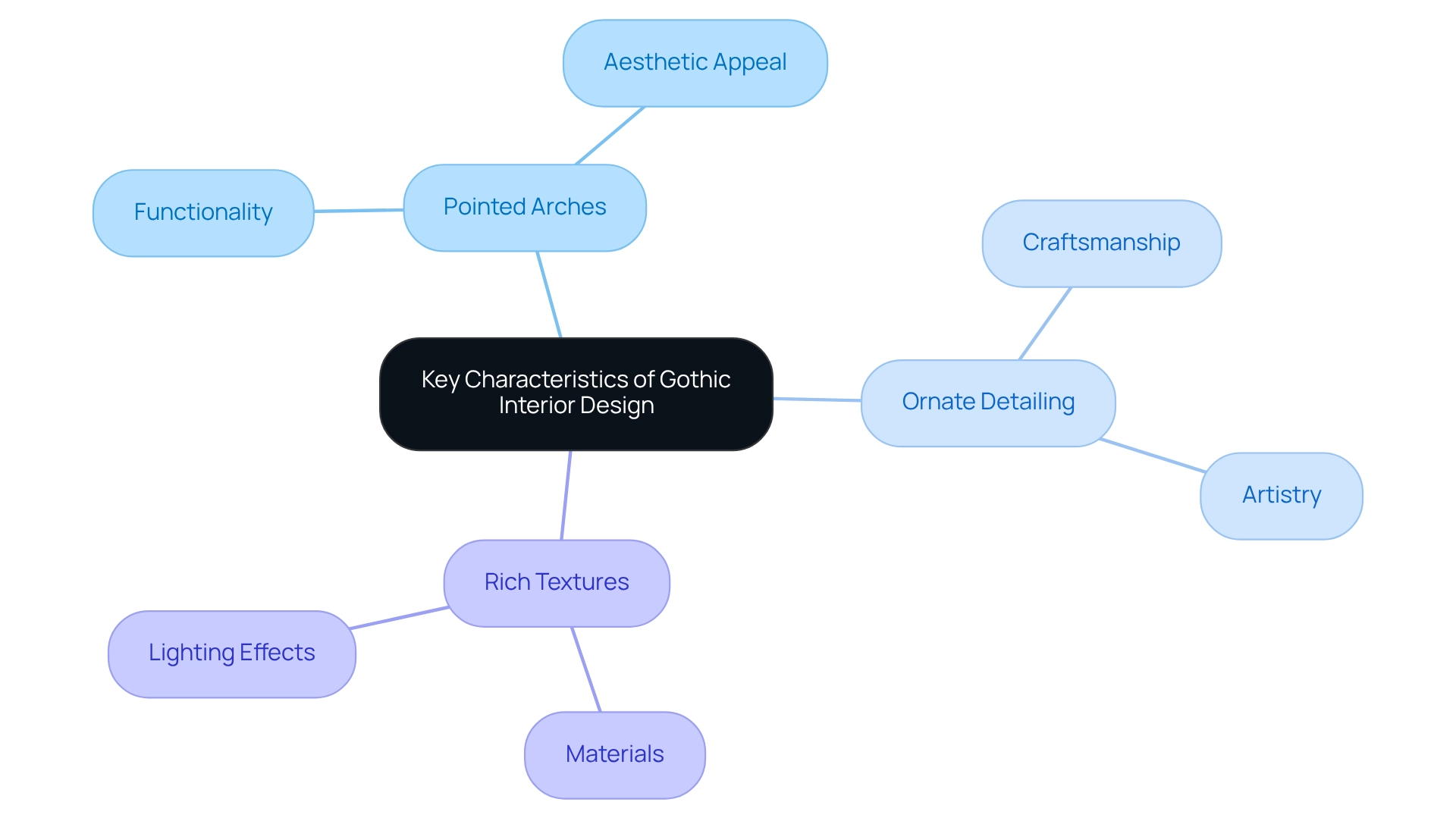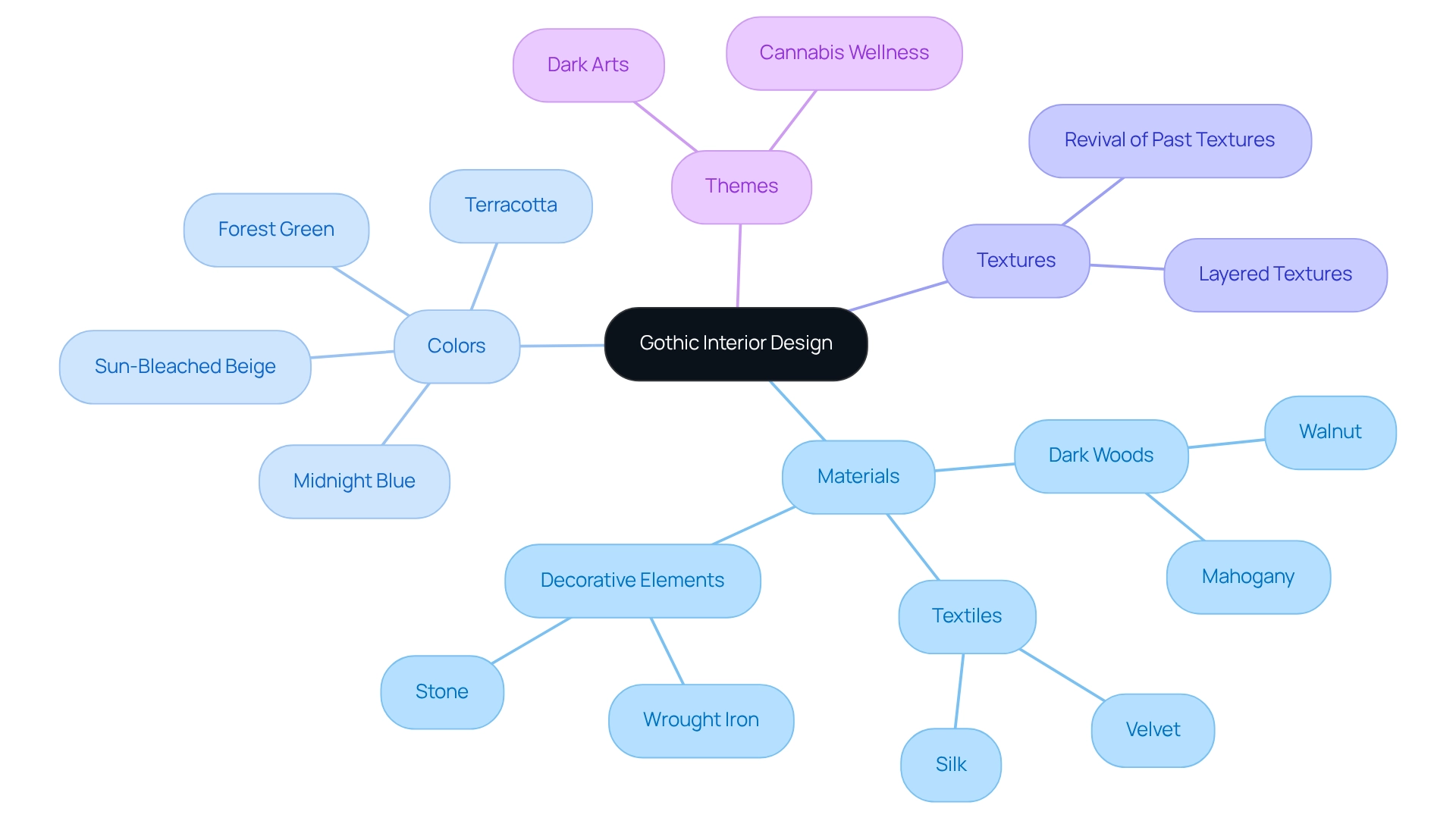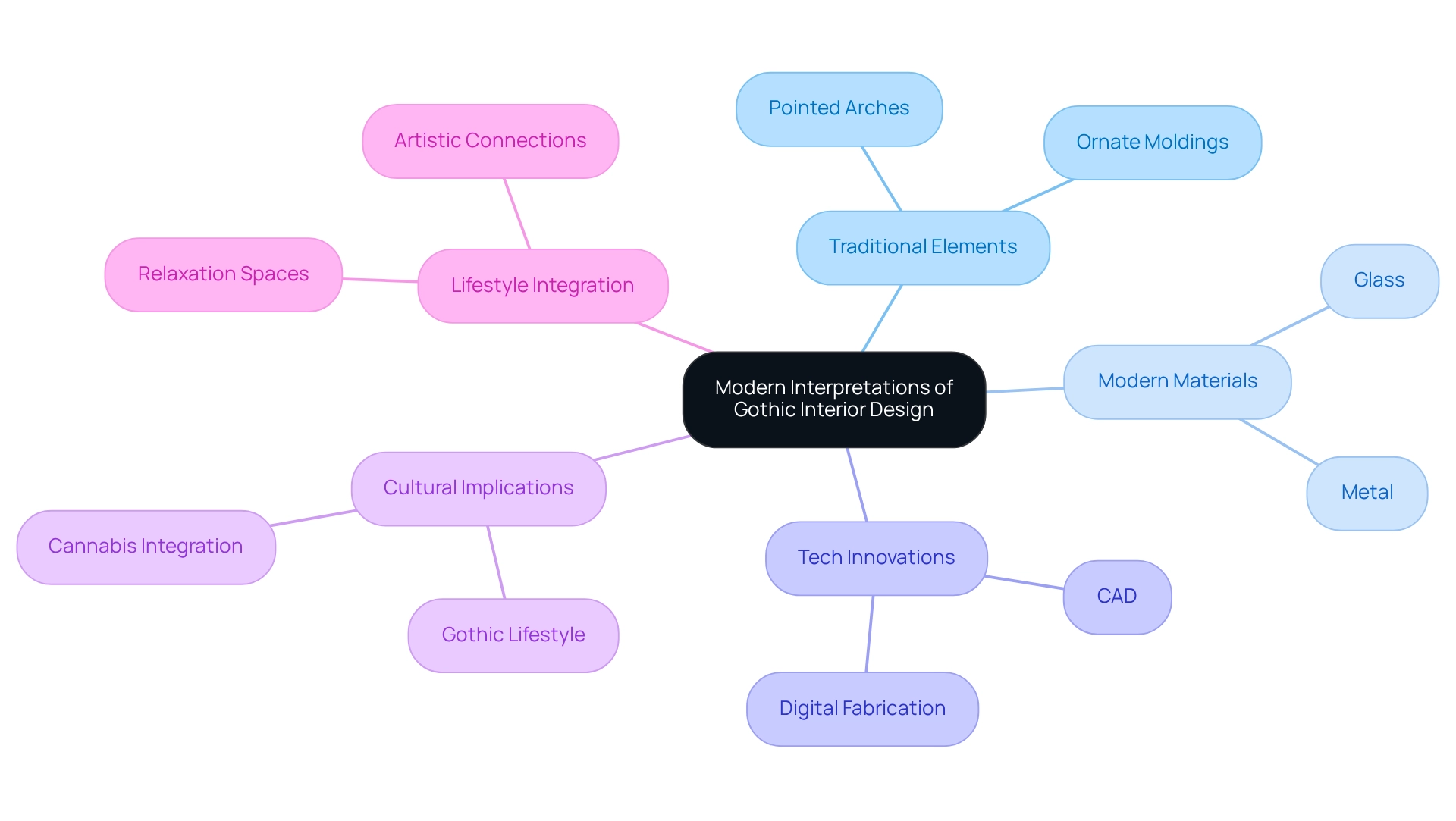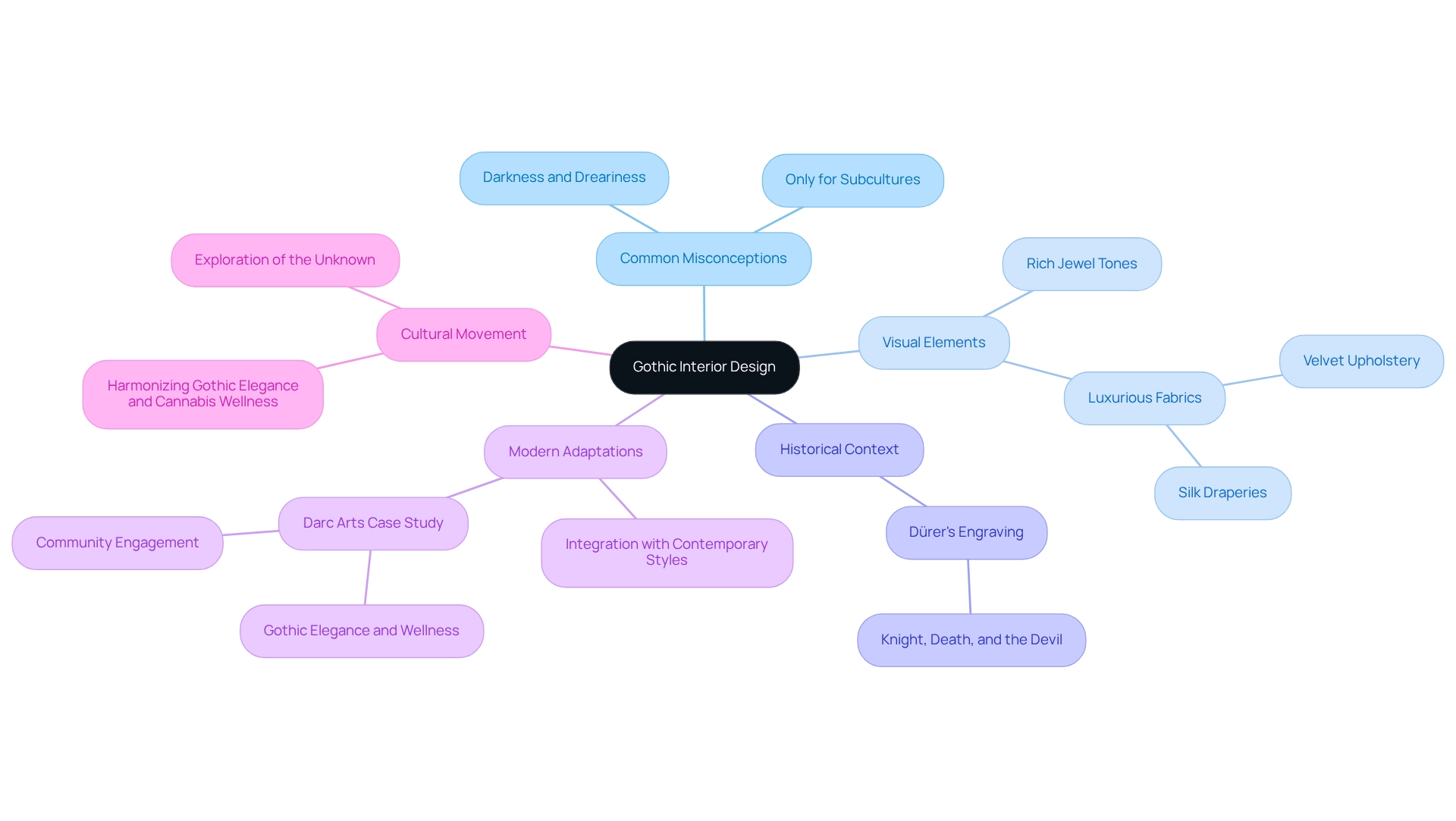
What is Gothic Interior Design? A Comprehensive Overview
Share
Overview
Gothic interior design—where drama meets opulence. Picture pointed arches looming overhead, rich textures wrapping around you, and deep color palettes that whisper tales of history and emotional depth. This style doesn’t just echo the past; it collides with modern aesthetics, crafting immersive environments that scream individuality and sophistication.
Think it’s all shadows and gloom? Think again. This article shatters the myths, revealing gothic design’s hidden warmth and elegance. Dive in, and let the allure of the gothic seduce your senses.
Introduction
In the world of interior design, Gothic style isn’t just a choice—it’s a statement. It whispers of the Middle Ages, where architectural grandeur meets an intoxicating allure. Imagine dramatic elements entwined with rich textures, crafting spaces that pulse with elegance and mystery. As we plunge into modern interpretations, Gothic interiors are reborn, fusing historical echoes with today’s sensibilities. Are you ready to explore the emotional landscapes these designs conjure?
From striking pointed arches that pierce the mundane to sumptuous fabrics draping luxurious furnishings, Gothic design transforms living spaces into immersive experiences. This isn’t just decor; it’s a journey into the depths of your individuality. As trends morph, the blend of Gothic elements with contemporary flair not only honors the style’s rich heritage but also amplifies its relevance in our world. It beckons those who dare to express their artistic spirit in their homes—will you answer the call?
Defining Gothic Interior Design: An Overview
Gothic interior design—it's not just a style; it's a visceral experience steeped in the dramatic and ornate. Picture this: the architectural grandeur of the Middle Ages, where pointed arches and intricate carvings whisper secrets of a romantic past. This isn't merely about aesthetics; it's about crafting an atmosphere that resonates with the shadowy, evocative facets of existence, urging you to delve into your emotional depths.
In today's world, Gothic designs seamlessly intertwine historical echoes with modern flair. Imagine spaces that are both timeless and relevant. The color palette? Think deep, sumptuous hues—burgundy, forest green, midnight blue—each shade a nod to opulence and grandeur. As Scott Maddux, co-founder at Maddux Creative, puts it, "In medieval-style decoration, hues often mirror the ambiance of the medieval period."
These rich tones dominate, creating an emotional landscape that's further enhanced by luxurious materials and intricate details. It’s an immersive experience that captivates the senses, drawing you into its depths.
Fast forward to 2025, and current trends in gothic interior design reveal a surge of distinctive styles. Platforms like Pinterest showcase designs that celebrate exploration and personal expression. Enter the Jellyfish aesthetic—serene, aquatic themes that have sparked a staggering 615% increase in searches for jellyfish lamps. This trend embodies a desire for tranquility and beauty, perfectly aligning with the ethos of crafting enchanting spaces.
Experts in the field note the emotional impact of architectural style, suggesting it can evoke nostalgia and self-reflection. By weaving contemporary interpretations of classic features into their homes, individuals can create environments that reflect their unique style while forging a deeper connection to history. This resonates with Dark Arts' mission: to cultivate a community that journeys into the unknown, merging wellness with gothic charm.
As the allure of gothic interior design continues to rise, it's clear this aesthetic offers more than mere visual appeal. It beckons you to embrace the shadows and uncover the elegance hidden within. Whether through dramatic lighting, ornate furnishings, or meticulously curated decor, the Gothic era's essence remains a powerful testament to individuality and artistic creativity in the modern home.
The Historical Roots of Gothic Design: From Dark Ages to Revival
In the 12th century, France birthed a pointed style that shattered architectural norms, marking a radical shift during the High Middle Ages. This movement wasn’t just about height; it was a quest for light, leading to the rise of awe-inspiring cathedrals adorned with ribbed vaults and soaring flying buttresses. Look no further than the Cologne Cathedral, a titan among Europe’s sacred spaces, a testament to the grandeur of medieval architecture.
These innovations ushered in larger windows, dripping with intricate stained glass, a hallmark of medieval allure.
As the medieval style morphed, its essence seeped into gothic interior design. Ornate furnishings, lush textiles, and elaborate decorative touches became staples of medieval interiors, embodying the very spirit of the grand structures they complemented. The 19th-century architectural revival reignited a passion for these medieval aesthetics, fusing them with modern sensibilities.
This revival didn’t just pay homage to the medieval past; it ensured its relevance, weaving its influence through various creative realms.
Consider the construction of Notre-Dame de Paris, which began in 1163 and spanned over 180 years. This historical endeavor showcases the enduring legacy of medieval architecture. Its flying buttresses and gargoyles weren’t merely functional; they were expressions of creativity and craftsmanship, allowing for soaring walls and expansive windows—a clear reflection of architectural advancement.
Today, the revival’s influence is palpable in contemporary interpretations of these elements, inspiring interior designers drawn to gothic aesthetics. As Bork noted, while Van Alen’s Chrysler Building may not scream medieval, its spires, gargoyles, and vertical stripes echo those historical influences. The defining traits of medieval architecture—pointed arches, intricate details—have seamlessly woven into gothic interior design, crafting spaces that resonate with history while satisfying modern tastes.
This ongoing dialogue between past and present underscores the significance of gothic interior design, leaving an indelible mark on modern spatial arrangements. It’s a narrative that reflects the sophistication and mystery of brands like Darc Arts, celebrating the allure that gothic design embodies.
Key Characteristics of Gothic Interior Design: Elements and Features
Medieval interior style? It’s a realm of sophistication and intrigue, where every detail whispers secrets of the past.
-
Pointed Arches: Not merely functional, these iconic features are stunning decorative elements that draw the eye upward. With their curved sides meeting at a peak, pointed arches allow for soaring structures and slender walls, crafting an ethereal atmosphere that lingers in the air.
-
Ornate Detailing: Intricate carvings and embellishments abound, infusing furniture and architecture with depth and richness. This ornate detailing is a testament to craftsmanship and artistry, making each piece a bold statement of style. Brands like Darc Arts embody this dedication to quality; their THCA diamond-coated pre-rolls, crafted from 100% premium indoor trim, resonate with the artistry of design. These pre-rolls promise not just a premium cannabis experience but also encapsulate the dark allure that captivates those seeking elegance and high-quality indulgence.
-
Rich Textures: Luxurious materials—velvet, brocade, dark woods—create a tactile experience that complements the visual drama of striking interiors. These textures beckon touch, enhancing the sensory journey of the space. Just as gothic design thrives on dramatic lighting and moody ambiance, the rich flavors of THCA products from Darc Arts mirror this luxurious feel. Imagine chandeliers and candle sconces casting shadows, filtered light through stained glass, creating an enchanting atmosphere. This interplay of light and shadow not only highlights architectural features but also weaves a spell of enchantment. Lighting is essential in ornate spaces, just as the therapeutic benefits of THCA illuminate the mind, offering clarity and calm—enhancing relaxation and creativity.
In modern architecture, pointed arches are making a comeback, blending traditional elements with contemporary needs. Think energy efficiency, acoustic performance, and security—all while preserving the iconic shapes of medieval windows. Statistics reveal a rising trend in new builds adopting pointed arches, signaling a revived love for this classic feature.
Case studies show brands like Darc Arts merging elegance with lifestyle branding, drawing in consumers craving experiences beyond the ordinary cannabis use. They cultivate a community around their products, appealing to those who value both aesthetic and cultural significance. This approach underscores the importance of medieval architectural features in today’s homes, where history’s charm meets modern living—much like the captivating essence of gothic interior design that Darc Arts weaves into the cannabis experience.

Materials and Textures: Crafting the Gothic Atmosphere
Materials in gothic interior design aren't just choices; they're the heartbeat of an ambiance steeped in luxury and allure. Dark woods—think mahogany and walnut—dominate the scene, crafting furniture and paneling that radiate warmth and richness, essential to the aesthetic. A surge in the popularity of these deep, moody woods reflects a shift towards palettes that resonate with contemporary tastes.
Imagine a palette where midnight blue and forest green collide with warm, sandy hues like terracotta and sun-bleached beige. It's a visual feast that commands attention. Textiles like velvet and silk amplify this opulence, inviting touch and admiration.
Wrought iron emerges as a key player in traditional styles, adorning decorative details and fixtures that heighten the atmosphere of intrigue and sophistication. The interplay of these materials crafts a layered environment, both inviting and enigmatic. Stone and masonry ground the design, linking modern interpretations to a rich heritage.
Fast forward to 2025, and current trends reveal a revival of textures that echo the past while embracing the now. Color drenching with deep blues, greens, and reds enhances Western style, transforming spaces into visually striking and emotionally resonant realms. Designers, by merging these materials thoughtfully, create an ambiance that encapsulates elegant style, making each space a unique reflection of its inhabitants' tastes.
This approach dances with the ethos of Dark Arts, urging consumers to intertwine cannabis wellness with gothic interior design. It's about crafting a community where aesthetic appreciation meets therapeutic benefits. Are you ready to embrace this lifestyle? Dive into the depths of a world where every detail whispers secrets and every choice is an invitation to explore the extraordinary.

Color Schemes in Gothic Design: Embracing Dark and Dramatic Hues
Gothic interior design is a dance with darkness, where dramatic color palettes reign supreme, sculpting the ambiance you crave. Think deep blacks, rich burgundies, and dark greens, all kissed by metallic accents—gold and silver that shimmer like secrets in the night. These shades evoke mystery and elegance, wrapping a space in intimacy while exuding grandeur.
The psychological impact of dark hues? Profound. They cradle you in comfort and security, sharpening focus and igniting creativity. Research reveals that a staggering 60% of people are drawn to darker color schemes in their homes, associating them with sophistication and depth. This allure perfectly aligns with the lifestyle championed by Darc Arts, where elegance and mystery are the heartbeat of gothic design.
Strategically wielding these colors highlights architectural features and furnishings, drawing eyes to intricate details while maintaining a cohesive aesthetic. Picture this: a room cloaked in dark walls, beautifully contrasted by lighter elements, enhancing the richness and depth of those darker tones. This interplay elevates the aesthetic, crafting a dynamic visual experience that lingers.
As we peek into 2025's decor trends, texture emerges as a key player alongside hue. Heavy fabrics like velvet and brocade add layers of richness, while thoughtful accessorizing with elaborate motifs—ornate candle holders or intricate wall art—further deepens the theme. Viktoria, a seasoned space designer with 16 years under her belt, notes that while this style dazzles, it can overwhelm smaller spaces, demanding more upkeep from dense textiles and intricate furnishings.
Case studies reveal that successful gothic interiors blend dark, dramatic palettes—think charcoal gray paired with deep plum accents—creating striking yet harmonious environments. The case study titled "Dark Arts: More Than Just a Product" showcases how the brand embodies dark elegance and wellness, cultivating a community around its unique aesthetic. Experts assert that when crafting contemporary architectural styles, balancing the boldness of dark hues with lighter elements is crucial to prevent the space from feeling oppressive.
This approach honors the historical roots of gothic design while adapting to modern tastes, ensuring timeless charm.
In essence, the impact of dark tones on medieval style is monumental, shaping the atmosphere and character of a space. By thoughtfully selecting and blending these hues, you can conjure a setting that reflects the sophistication and intrigue woven into this architectural style, much like the experience offered by Dark Arts.
Modern Interpretations of Gothic Interior Design: Blending Tradition with Contemporary Style
Contemporary interpretations of historical style blend classic features with modern appeal, crafting spaces that pulse with both timeless quality and fresh allure. Designers are weaving sleek lines and minimalist furnishings into the fabric of traditional architectural elements—think pointed arches and ornate moldings. This fusion doesn’t just refresh the aesthetic; it makes architectural style accessible, inviting a wider audience to explore.
Picture this: large windows, a hallmark of contemporary architecture, invite natural light to flood interiors, amplifying the dramatic impact of these features while preserving an airy vibe. The dance of light and shadow reveals the intricacies of medieval architecture, casting a spell of captivating ambiance. With contemporary materials like glass and metal in the mix, striking contrasts emerge, spotlighting the sophistication of architectural elements.
Architects are harnessing cutting-edge technologies—CAD, digital fabrication—to conjure intricate structures that meet modern standards. This tech-savvy embrace allows for precise, creative interpretations of architectural elements, ensuring that designs are not just visually stunning but also practical and sustainable.
As we edge closer to 2025, the evolution of contemporary interior styling unveils inventive ways to marry the traditional with the modern. Case studies reveal that successful designs often showcase a thoughtful balance of classic architectural motifs and modern practicality, maintaining the essence of elegance while addressing the pulse of contemporary life. The importance of accredited architectural programs in the Gothic style highlights the value of real-world applications in grasping gothic interior design, equipping individuals to appreciate and contribute to this rich visual culture.
For cannabis enthusiasts, contemporary aesthetics craft inviting spaces that amplify relaxation and enjoyment, especially when paired with the premium offerings from Dark Arts. Imagine integrating ornate elegance into settings where cannabis is savored, like the THCA diamond-coated pre-rolls at $49.99. This fusion invites individuals to forge a deeper connection with the artistic and cultural layers of their lifestyle. Such adaptability not only keeps gothic interior design relevant but also sparks a new generation of enthusiasts, intertwining the gothic lifestyle with the cannabis experience that Darc Arts delivers.

Incorporating Gothic Elements into Your Home: Practical Tips and Ideas
Integrating dark architectural features into your home? It’s not just enjoyable; it’s a statement. Picture this: premium cannabis products from Darc Arts enhancing your space. Here’s how to dive into the depths:
- Choose a Focal Point: Go for something dramatic—a Gothic-style chandelier or an ornate mirror. This piece isn’t just decor; it’s the heartbeat of your room, much like the captivating allure of Darc Arts' THCA offerings, designed to conjure calm and tranquility.
- Layer Textures: Mix materials—velvet cushions, silk curtains, wooden furniture. This isn’t just about comfort; it’s about creating a rich, inviting atmosphere. The interplay of textures adds depth, echoing the luxurious experience of indulging in high-quality cannabis that restores and relieves.
- Use Dark Colors: Paint those walls in deep hues or adorn them with ornate wallpaper. Dark colors evoke medieval design, creating a cozy, intimate environment—perfect for enjoying Darc Arts' products, crafted for those who dare to transcend the ordinary.
- Accessorize Thoughtfully: Bring in gothic elements—candelabras, wrought iron accents, vintage artwork. These aren’t mere accessories; they’re conversation starters, reflections of your unique style, akin to the distinctive experiences offered by Darc Arts' THCA diamond-coated pre-rolls.
- Balance with Modern Elements: Marry traditional features with contemporary furnishings. This isn’t just design; it’s a harmonious blend that feels fresh and inviting. It’s about understanding classic design in a modern context, just as Darc Arts elevates cannabis culture with sophistication and elegance.
As consumer spending on home décor rises—especially in dark aesthetics—these tips guide you in crafting a space that embodies elegance and mystery. By selecting focal points and balancing classic features with modern touches, transform your home into a sanctuary that reflects your appreciation for life’s darker side. And consider how Darc Arts' products, crafted with 100% high-quality indoor trim and priced at $23.99 USD for a 5-pack of THCA Hybrid Pre-Rolls, can elevate your dark-themed decor, enriching your atmosphere and lifestyle.
The case study 'Darc Arts: More Than Just a Product' illustrates the brand's fusion of wellness and gothic design, inviting you to explore the intersection of cannabis culture and gothic aesthetics in your home.
Debunking Myths: Understanding the True Nature of Gothic Interior Design
This style of interior decor, despite its rising popularity, is often shrouded in confusion. Think medieval architecture has to be dark and dreary? Think again. In reality, this style can be strikingly graceful and inviting, wielding light and color to conjure a cozy, friendly atmosphere.
Imagine this: rich jewel tones and sumptuous fabrics transforming a space into a realm of sophistication and comfort. Huston puts it perfectly: "I also like to add velvet upholstery or silk draperies in deep jewel tones to add that touch of luxury and prevent the space from feeling too austere."
But here’s another kicker: the Gothic style isn’t just for the subculture. Its deep historical roots and aesthetic allure make it a treasure for anyone who appreciates beauty and craftsmanship. Medieval architecture can dance seamlessly with modern styles, crafting environments that resonate with a broader audience.
Statistics reveal a staggering truth: many still cling to misconceptions about medieval interior design, often tying it solely to shadows and despair. Take Durer's engraving 'Knight, Death, and the Devil'—a piece rich in detail and themes of mortality that echo medieval styles. By shattering these myths, we can revel in the charm and versatility of architectural aesthetics.
Experts assert that architectural style can embrace contemporary elements, making it a fit for diverse tastes and lifestyles.
Consider case studies like 'Darc Arts: More Than Just a Product.' Here, the dark aesthetic transforms into welcoming, stylish spaces that challenge conventional views. Darc Arts cultivates a community around its offerings, inviting consumers to delve into the gothic aesthetic and embark on a journey into the unknown. By intertwining gothic elegance with cannabis wellness, Darc Arts opens the door for a broader audience to explore the depths of gothic interior design, fostering a greater appreciation for its sophistication and adaptability.
Join our movement, where elegance, cannabis culture, and the allure of the unknown intertwine.

Conclusion
Gothic interior design isn’t just a style; it’s a bold statement of historical elegance and emotional depth. Rooted in the architectural grandeur of the Middle Ages, it captivates with dramatic elements, rich textures, and intricate detailing. Pointed arches and sumptuous fabrics beckon you to dive into your personal narrative, embracing the beauty of the past while making it your own in today’s world.
As trends shift, modern Gothic interpretations fuse tradition with innovation. New materials and techniques breathe life into Gothic aesthetics, making them accessible to all. This adaptability keeps the elegance and mystery of Gothic design alive in contemporary homes, crafting spaces that scream individuality and artistic expression.
But this journey into Gothic design is more than just aesthetics; it’s an invitation to explore the emotional landscapes these spaces evoke. By weaving Gothic elements into your living environment, you cultivate an atmosphere that enchants and reflects your unique taste. With the rise of this style, seize the chance to celebrate the rich heritage of Gothic design while carving your own path in modern decor. Embrace the shadows, and let the elegance of Gothic interiors transform your space into a sanctuary of artistic expression and timeless beauty.
Frequently Asked Questions
What is Gothic interior design?
Gothic interior design is an immersive experience characterized by dramatic and ornate elements, inspired by the architectural grandeur of the Middle Ages. It combines historical echoes with modern flair, creating an atmosphere that resonates with emotional depth.
What are the key color palettes used in Gothic interior design?
The color palette in Gothic interior design features deep, sumptuous hues such as burgundy, forest green, and midnight blue, each reflecting opulence and grandeur.
How does contemporary Gothic design differ from historical styles?
Contemporary Gothic design incorporates modern sensibilities while maintaining classic features. It celebrates personal expression and exploration, often seen in trends like the Jellyfish aesthetic, which emphasizes tranquility and beauty.
What emotional impacts does Gothic interior design have?
Gothic interior design can evoke nostalgia and self-reflection, allowing individuals to create environments that reflect their unique style while connecting them to history.
What are some key elements of Gothic interior design?
Key elements include dramatic lighting, ornate furnishings, lush textiles, and intricate decorative touches that embody the spirit of medieval architecture.
How has the revival of Gothic design influenced modern architecture?
The revival of Gothic design has ensured its relevance in contemporary architecture, inspiring designers to incorporate elements like pointed arches and intricate details into modern spaces.
What historical significance does Gothic architecture hold?
Gothic architecture, originating in the 12th century, marked a radical shift in architectural norms, leading to the construction of awe-inspiring cathedrals and larger windows adorned with intricate stained glass.
How does Gothic interior design reflect individuality and creativity?
Gothic interior design allows for the expression of individuality through the integration of historical elements with personal style, creating unique and enchanting spaces that reflect the homeowner's artistic vision.
